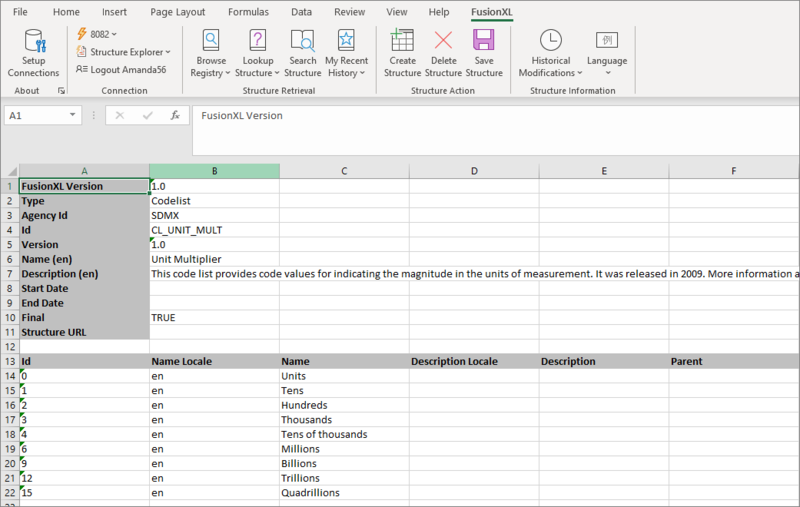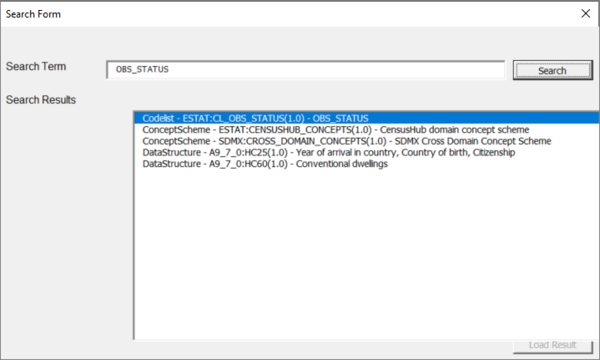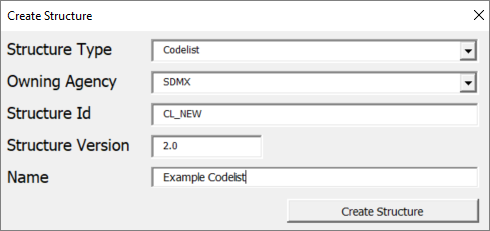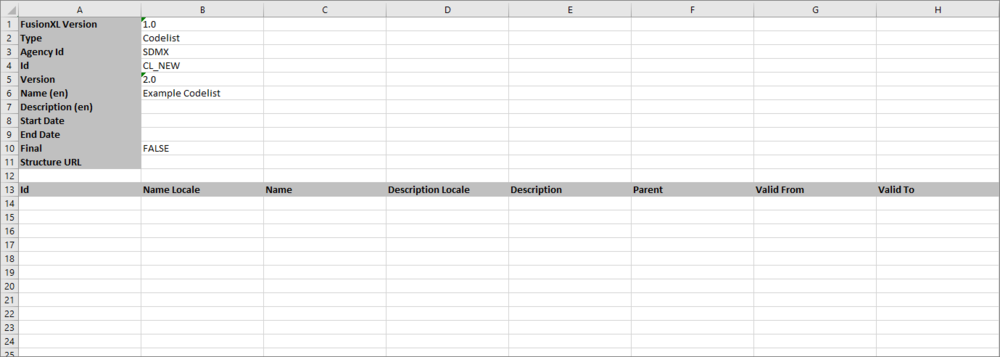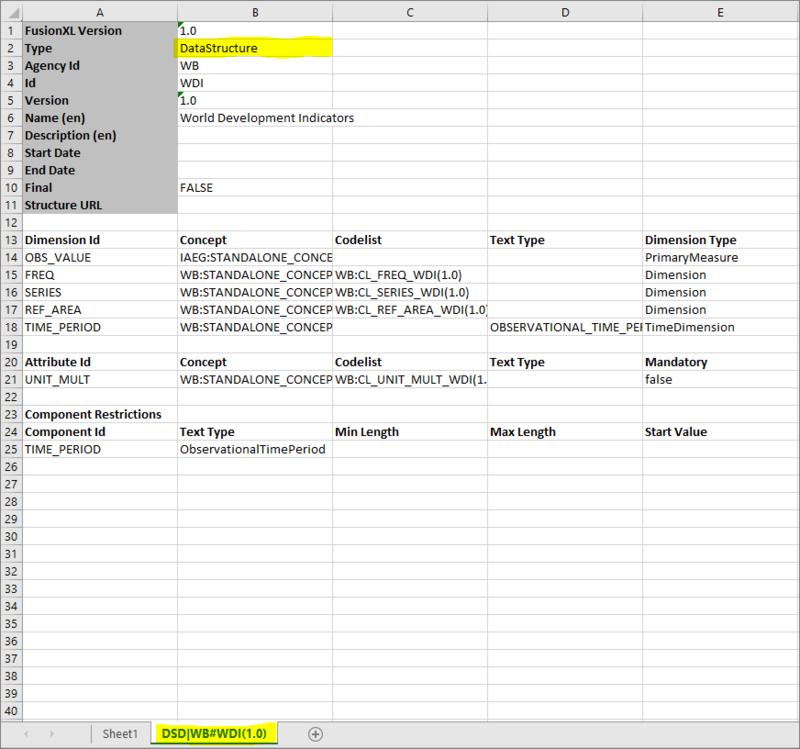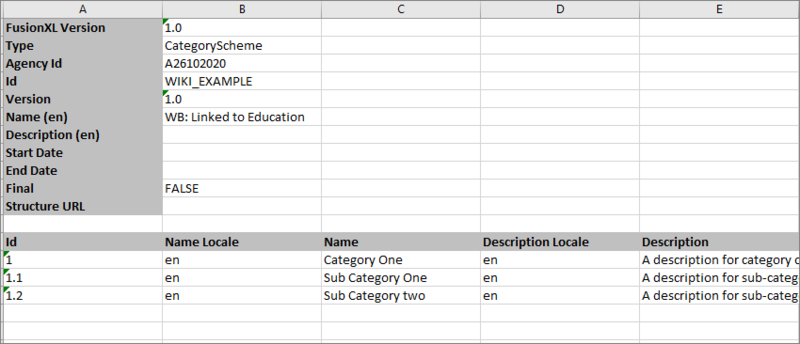Difference between revisions of "Structure Explorer"
(→Structure Format) |
(→Category Scheme) |
||
| Line 142: | Line 142: | ||
The layout for the remainder of the worksheet depends on the structure being created/modified. | The layout for the remainder of the worksheet depends on the structure being created/modified. | ||
| − | ==Category Scheme== | + | == Category Scheme== |
| + | A Category Scheme is a hierarchical scheme of Categories. Each category has a mandatory id and name, and an optional description. | ||
| + | |||
| + | |||
| + | [[File:FXL21.PNG|800px]] | ||
| + | |||
| + | The Category Id can contain a period ‘.’ separator to indicate parentage. In the example above category with id ‘1.1’ is a child of category with id ‘1’. A Category may contain more than one ancestor, for example ‘1.1.1’ would be a valid id, denoting category ‘1.1’ as the immediate parent, and category ‘1’ as the grandparent. | ||
==Cdelist== | ==Cdelist== | ||
Revision as of 06:10, 15 April 2021
Prerequisites
To use the Structure Explorer you need to have installed the FXL add-in and connected to a Registry from the FusionXL tab in an Excel workbook. Click here to learn how to do that.
If you intend to modify structures you will also need to Login with your Registry username and password.
The image below show the Connected Registry along with the name of the logged in user.
Features Overview
These functions are grouped into 3 areas:
- Structure Retrieval
- Structure Action
- Structure Information
Read on to learn more.
Structure Retrieval
There are 4 ways to retrieve structures from the Registry. Regardless of how a structure is retrieved, the retrieval of the structure will result in a new worksheet being opened. Thus it is possible to have an Excel workbook with multiple worksheets, one for each retrieved structure.
Browse Registry
This button displays a hierarchical menu of all the structures in the connected Registry, broken down by structure type followed by Agency, as shown below.
Once a structure is selected, for example SDMX:CL_UNIT_MULTIPLIER(1.0), FusionXL will obtain this codelist from the connected Registry, and the resulting structure will be shown in the Excel worksheet, as shown in the example below.
Lookup Structure
Lookup Structure provides a drop down menu of Registry content where the structures have been organised into folders depending on which structures reference them. This is a very useful mechanism for quickly finding the desired structure, as well as a useful tool to discover which structures make use of other structures.
It should be noted that whilst then ‘Browse Structures’ menu displays all Registry content, ‘Lookup Structure’ may be showing a subset, depending on the Registry content.
Search Structure
The Search Structure provides a free text search of Registry content. The search terms are applied to Ids, names, descriptions of all Registry structures. A search on OBS_STATUS for example will bring back the concept schemes that contain the OBS_STATUS concept, and Data Structure Definitions with dimension Ids of OBS_STATS, as shown below.
To load a result, either double-click on a search result, or select the result and click the Load Result button.
My Recent History
My recent history shows up to the last 10 structures retrieved against the current Registry connection with the most recently retrieved structure shown first in the menu. If the Registry connection is changed in the Setup, the recent history is updated to show the history of structures retrieved for that connection.
By clicking on a Recent History item, the structure will be retrieved, and the item will be moved to the top of the Recent History menu.
Structure Action
The Structure Action options provide support for the creation, deletion, and modification of structures. Both Delete Structure and Save Structure will only be enabled if a structure has first been retrieved from the Registry. Authentication is performed for any Registry modification, and if authentication is required a login window will be displayed which will enable entry of a username and password.
Create Structure
To create a structure you need to be logged in to the connected Registry.
The Create Structure button opens up a window which enables you to select a structure type (please note that only Codelist, Category Schemes and Concepts schemes are functional in the current version of FXL).
Next, select the Agency from the drop down list. Enter a Valid Structure ID (example CL_NEW), version and the name of the Structure as shown in the example below:
Click Create Structure and a new worksheet will open as shown below.
The data can now be added directly into the spreadsheet. The image below shows some guidance.
When you have finished adding data, you can use the Save Structure Button. The registry will validate the data and then, if successful save the structure to the connected Registry.
Multi-Lingual Structures
Although, as show in the guidance image, it is possible to create multi lingual structures using FXL, you will note that there is only one column for for a Descrptions and as a result you have to choose either fr or en (in this example I have used fr).
If you require a description in both languages, you can amend the spreadsheet as shown in this example. Using this method, you can add any number of languages. In this example, the language indicator is ru, to identify that the data is in Russian.
If you are using multiple languages, one saved you will be able to use the Language button to display the data in the chosen language.
Save Structure
To save a structure you need to be logged in to the connected Registry. Use this button to Save any modifications made to a structure.
Delete Structure
To create a structure you need to be logged in to the connected Registry.
After loading the structure you wish to delete, select the Delete Structure button.
The system will prompt for confirmation and report that the structure has been deleted from the connected Registry, FXL will not close the worksheet thus leaving it available for further modification (alternatively, close the worksheet).
Historical Modifications
The Historical Modifications menu item displays a list of all the modifications for the selected structure. Each time a structure is saved back to the Registry the modification is stored and backed up. This makes it possible to view, and roll back to any previous instance of the structure. To do that, simply select the revision from the list and that version will be loaded into a new FXL worksheet.
Working with Retrieved Structures
As explained in the Retrieval sections above, there are a number of ways to obtain a structure from the connected Registry but what happens next is the same.
Structure Format
Fusion XL will open the retrieved structure in a new worksheet. Each Structure Type has a defined format in FusionXL, with the header information in rows 1 to 11, followed by the structure specific details. The example below is of a Data Structure.
| Row number | Name | Details |
|---|---|---|
| 1 | FXL Version | Information about the version of the FusionXL communication protocol (note this is not related to the version of the FusionXL plugin), the Registry uses this information to know how to process the message. This value is generated by the Registry and should not be modified. |
| 2 | Type | Determines the type of structure that the worksheet is defining. This value is generated by the Registry and should not be modified. |
| 3 - 11 | Various | Defines information about the structure, and can all be modified as appropriate. |
The layout for the remainder of the worksheet depends on the structure being created/modified.
Category Scheme
A Category Scheme is a hierarchical scheme of Categories. Each category has a mandatory id and name, and an optional description.
The Category Id can contain a period ‘.’ separator to indicate parentage. In the example above category with id ‘1.1’ is a child of category with id ‘1’. A Category may contain more than one ancestor, for example ‘1.1.1’ would be a valid id, denoting category ‘1.1’ as the immediate parent, and category ‘1’ as the grandparent.











